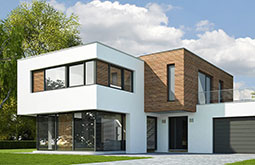A Essential Guide on 3D Rendering - Process and Benefits
3D rendering has come a long way from being limited to only video games. 3D-based technology is now integral to modern digital marketing and visual design. From big-budget movies to TVCs, product development, and AEC and interior designs, 3D-rendered visuals are everywhere.
With time, 3D visualization has evolved so much that one cannot even think it is there. The technology has ample benefits across multiple sectors owing to its simplicity, accessibility, and lower cost.
However, even now, some still wonder about 3D-rendered visualization and question the technology. This article aims to give all the basic details about 3D-based rendering and its benefits. But before delving deep, let us first understand what it is.
What is 3D rendering?
3D rendering is the digital process of converting a 3D model into a 2D image. The 3D design software analyzes the 3D model data, i.e., textures and lighting, and creates a photo-realistic 2D image or moving animation. This entire procedure is termed the “rendering process.” The more advanced the software is, the higher the rendered quality.
The preliminary process of 3D modeling is similar to a professional photographer setting up the props, lighting, and camera before taking the snaps. And the entire rendering process could be considered similar to when the photographer clicks a photo of the entire scene.
The highly detailed and ultra-realistic rendered images are applied to various creative representations that accurately convey a designer’s artistic concepts.
The technology is not just used for product manufacturing and designing, but also for marketing purposes. For the latter, the 3D models are rendered in two different stylistic presentations:
-
White background renders
eCommerce products, such as electronic appliances, apparel, jewelries, etc., are usually rendered against a clean, white background. This emphasizes the key details and product highlights; it helps consumers understand a product better and make informed purchases.
White-background rendered shots prevent any distraction in the background that can deviate buyers’ focus from the actual product.
-
Lifestyle renders
When marketers want to convey the utility and functionality of a product, they resort to lifestyle-rendered shots. Such renders are usually done in the furniture industry, wherein the products are placed in a real-world setting.
These 3D visuals help buyers understand how the furniture will look in their environment. Such realistic visualizations also inspire them to buy the product and relish its comfort.
A brief history of 3D rendering
The history of 3D rendering can be dated back to the 1960s. William Fetter, was the pioneer in exploring the concept and the fundamentals of computer animation. He was also the first one to coin the term “Computer Graphics”, or CG. Shortly, he created the first 3D model of a pilot in a Boeing jet cockpit simulating real world flight interiors. The model was famous as the “Boeing Man” or the “Boeman”.
In the following years, the world saw what could be deemed as the first 3D rendering. Ivan Sutherland created world’s first 3D rendering software, Sketchpad, during his times at MIT. This simple computer program set the flow towards more research and development in computer rendering.
Then in the mid 1970s, an iconic incident occurred; Martin Newell, a University of Utah researcher created the “Utah Teapot”, which can be considered as the first near-accurately 3D rendered visual. Soon the teapot became so much important that it was considered as an ideal standard sample reference in the 3D visualization fraternity. SImply put, it was a big leap in the evolution of 3D rendering.
The 1980s undoubtedly saw a great deal of R&D happening. The technology became one of the most preferred techniques of CGI enthusiasts. Some of the famous rendering programs were developed during this time, such as AutoCad in 1983, Pixar’s RenderMan. Popular movies and video games also saw a great deal of 3D modeling and visualizations. 3D technology was no longer an elite technology limited to the academic fraternity. Toy Story in 1995, revolutionized the global sector of animated movies as we see them now. For the first time, an animated movie has full rendered graphics, that was loved by the audience.
From the mid 90s until the present, 3D software rendering technology has undergone several innovations. So many new software are available now, graphics are also hyper-realistic. Besides, so many rendering techniques are being used by 3D professionals. AR, VR, AI-based Metaverse, are all a big part of the overall rendering technology. Together these create real-world simulated visuals for the viewers.
How does 3D rendering work?
3D rendering majorly involves developing a virtual environment or scene in 3D. The scene can have an array of 3D models of organic or inorganic objects. These models are done in advanced 3D modeling software by professional 3D modelers.
- First, wireframes are created, and then textures are added to the models.
- The textures replicate real-life surfaces consisting of diffusion, color, reflections, refractions, etc. They can have rough, shiny, metallic, leathery, gritty, groovy, or smooth surfaces, depending on the requirement.
- Soon after, the rendering artist sets up the camera, materials, and lighting, incorporating the models within the scene.
- Finally, the rendering program starts interpreting the 3D data and materials, and the two-dimensional images are generated with high photo-realistic quality. The software makes these interpretations through complex mathematical calculations.
- Based on the project scope and expected quality, elements like camera angles, lighting, effects, and textures are adjusted. The more perfection, the greater the rendering quality.
Given the technicalities involved in the process, it is always recommended to collaborate with professional 3D rendering agencies. They are backed by professionally trained renderers who are masters of the art. These experts carry out the process with the utmost precision ensuring a fast turnaround.
Two types of 3D rendering
3D rendering can be divided into two main categories based on the technology they run on.
-
Real-time rendering
As the name suggests, real-time rendering works on the technology of real-time user interaction. The 2D images are generated in real-time based on the user input. Usually, in high-end computer video games, we get to see this feature where millions of 3D data get analyzed instantly based on the user’s inputs.
Thereafter within seconds, the 2D images are produced and shown onscreen. Besides video games, interactive 3D UIs also operate on this technology, where realistic environments are produced based on user interactions.There are several real-time rendering techniques that create real-world impressions based on external actions. Two of them are the most common and advanced:
- Rasterization technique, and,
- Ray-tracing technique
Lastly, there’s a metric that determines the quality and seamlessness of the rendered images produced with the real-time process. That is, FPS or frames per second. This is an equation for understanding the number of frames generated in one second. Higher the FPS, the smoother the visuals and user experience.
(Note: For the best smooth and seamless visual experience, the images must be rendered in less than 1/30 of a second by the system).
-
Non-real-time rendering
Non-real-time, or offline rendering, is the stark opposite of real-time rendering in generating 3D visuals. Here, everything is calculated beforehand by the software program. No user interaction or viewer involvement is required in this process.
Thus, the system doesn’t have to interpret the scenes within a set time. Which is why the images generated with this process are ultra-realistic.
This process is mostly used for animated movies, cinematographic presentations, as well as real estate 3D visualizations. These 3D visualizations are so popular in the real estate industry that they have almost replaced traditional photoshoots.
The photos or visuals generated are of top-notch quality, bearing photo-realistic similarity to real-world object. That’s why the animated movies produced by Dreamworks Productions, Pixar, or Ghibli Studio are so detailed. All of these movies are done with the non-real-time rendering process.
Professional agencies offering high-end 3D modeling and rendering services are the best solution for this. They leverage the latest technologies and have advanced hardware that give world-class quality rendering.
What are 3D rendering engines?
3D rendering engines are add-on software plugins that facilitate different rendering methods. These engines usually come integrated within a software, although standalone 3D rendering software are mostly used by professionals.
Some of these plug-ins are compatible with multiple software applications. And some are exclusive to one. While converting 3D scenes into 2D image or animation, some of the technique these engines use are:
- Ray-tracing (discussed above)
- Path tracing
- Rasterization (discussed above)
- Shading
- Depth of field
- Volumetric lighting
- and so on.
Benefits 3D rendering has across mainstream industries
3D rendered visuals can effectively transform the way several businesses are done. The technology has myriads of practical advantages for several leading sectors such as eCommerce, real estate, product manufacturing, automotive, healthcare, and so on.
Some of the proven benefits 3D rendered images have on these industries are as follows:
-
Accurate depiction of measurements
3D-rendered visuals depict accurate measurements since they are replicated from real-world objects. Such scaled details are mostly required for developing interior floor plan designs. 3D floor plan designs give exact measurements and distance between rooms, walls, floor area and so on.
-
Saving production costs
Product prototypes can be developed and rendered even before the actual production happens. During the development stage, production engineers can analyze the high-quality digital models rendered in 3D. This benefits bigger architectural construction projects, as well as eCommerce products or electronic gadgets development.
-
Identifying potential design flaws
While examining the models during the planning and development stage, potential design errors can be detected. These flaws can be rectified right away saving any future dangers. This is extremely crucial for the automobile industry, and also for the real estate. In both these areas, any flaw in design can create serious hazard in the future.
-
Adds versatility in product presentation
With 3D visuals, eCommerce brand owners can enhance their product listings. This is applicable for furniture, jewelry, and apparel brands. They are in constant pursuit to attract more leads. Product photos rendered in 3D and presented beautifully, convince and entice prospects triggering their emotions.
-
Facilitating product transparency
For any online shopper, product transparency is the main priority. Text-based lengthy descriptions and flat 2D images fail to offer such transparency thus discouraging them from buying. 3D product renders not only give accurate product details, but also give a clear idea of its utility and functionality. Therefore, everything is crystal clear to the buyer.
-
Helping buyers make more informed choices
When buyers are more confident about a product, it helps them to make more informed purchase decision. Whether a couch or a bed will look good in their actual environment or not, they can understand that from lifestyle rendered product shots. Thus, they can leave any guesswork behind and be confident about their purchase.
10 best 3D rendering software
As mentioned, plenty of R&D in the field of CGI and computerized rendering have been there since the 90s.
Quality of the rendered-visuals have also become superior. These days one cannot tell apart between a photographed object and a rendered visualization.
This exceptional quality upgrade have only been possible with modern software applications. With the advent of these advanced tools, 3D rendering is now a mainstream for all sectors. Below is a handy list of some of these tools that professional rendering artists use. Few of the 3D rendering software are also great for beginners and novices. Bookmark this list for quick reference.
- and so on.
Final words
To sum up, 3D rendering or converting 3D models into 2D images for viewing with the help of a software is a breakthrough tech innovation with superior benefits. If used wisely, 3D-rendered visuals can bring a paradigm shift in the way visualizations are created. Clients can have deeper product insights, architectural constructions can be more flawless, sellers can entice more buyers, and so on.
Hope you have gained adequate insights on the concept, how it works, and the benefits it gives. Given the technicalities involved, seeking professional expertise and teaming up with a partner is best.
But the key challenge is finding the right 3D rendering services provider. In our next article, we will talk about some of the best 3D designs and visualization service providers of 2025. As well as some effective tips for finding the right 3D services partner. So, stay tuned!
Frequently Asked Questions
3D rendering enhances visualization by creating realistic digital images of products, buildings, or concepts before production. It improves decision-making, reduces costs, and streamlines design iterations. Businesses use it for marketing, prototyping, and presentations to showcase products with stunning visuals before manufacturing or construction.
A 3D render converts a digital 3D model into a high-quality image or animation using lighting, texturing, and shading. Rendering engines simulate real-world physics to produce lifelike visuals. It involves processing the model’s geometry, materials, and environment settings to generate a final polished output.
3D modeling involves creating a three-dimensional digital object using specialized software. It defines shapes, structures, and dimensions. 3D rendering, on the other hand, transforms these models into realistic images or animations by applying textures, lighting, and visual effects to produce photorealistic results.
Common 3D rendering techniques include Ray Tracing (realistic lighting/shadows), Rasterization (fast, real-time rendering), Global Illumination (realistic light bouncing), and Ambient Occlusion (soft shadows for depth). These techniques enhance realism and efficiency in industries like architecture, gaming, and product visualization.
Types of 3D rendering images include Photorealistic Renders (lifelike images), Non-Photorealistic Renders (stylized visuals), Wireframe Renders (structural outlines), Interior & Exterior Renders (architectural visualization), Product Renders (marketing materials), and 360-Degree Renders (interactive views). These cater to industries like architecture, gaming, and eCommerce.




